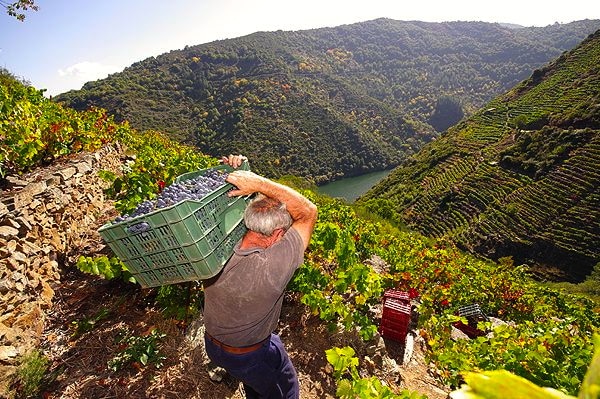Guimaro
Cultivated since Roman times, Ribeira Sacra’s steep terraced vineyards are some of the most picturesque and treacherous to work in the world of wine – think of the Douro, Cote Rotie, or the Mosel. Like those most dramatic terruños, winegrowing here is not for the faint of heart; it takes spirited determination, eternal optimism, a sense of tradition, and a willingness to collaborate. Pedro Rodríguez of Adegas Guímaro embodies all of these qualities.
Pedro descends from a long line of winegrowers working in the Amandi area, Ribeira Sacra’s most prime subzone of south facing vineyards planted on local Losa slate, just above the river Sil. The previous generation, his parents Manolo and Carmen, still work with him in the vines. The family also maintains a small finca of mixed agriculture, very common in Galicia, raising chickens, rabbits, pigs, and cultivating a sizable vegetable patch near the adega (winery) which the family built in 1991.
They named their winery Guímaro (meaning “rebel” in Gallego) a term which has a special connection to history of this area. Local traditions honor an ancient revolt when armed brotherhoods, called Irmandades, challenged the local feudal nobility in the Irmandiño wars of the 15th century. Masses of peasants and townsfolk tore down castles at Monforte de Lemos, Sandiás, and elsewhere in Galicia, but the better equipped nobles eventually suppressed the revolution. But the Irmandiño Wars have a particular resonance as a historical expression of rural Galician identity as independent, self-reliant, and locally focused: the Guímaros as local farmers fighting off interfering foreign nobles.
Before 1991, Pedro’s family produced small quantities of wine for their own consumption and sold their wine in garrafones – 20-liter glass containers – to local cantinas. It was Luis Buitrón, an enologist from León that was instrumental in the creation of the Ribeira Sacra D.O. (and is now a close family friend), who helped the Rodríguez family to start estate-bottling their wines in the early 1990s. Guímaro was one of the first adegas to join the appellation when it was founded in 1996. Like other traditional winemaking regions of inland Galicia, the area was in steep decline until the early 1990s. The terraced vineyards are difficult and expensive to work, but the grapes and wines did not demand a high price on the market. Many small farmers left, either emigrating from Spain or to the cities: the local province of Lugo lost nearly half of its residents between 1940 and the 2020. The result was widespread abandonment of prime vineyard land. Intensifying that decline, the Franco regime constructed hydroelectric dams all along the Miño and Sil rivers, altering their flow and creating reservoirs that transformed the microclimates of the vineyards along the banks. The presence of standing water has meant new struggles with humidity and mildew. But the establishment of the D.O. has steadily reversed the area’s decline, as viticultores have collaborated to recover the region’s vineyards, restore the area’s reputation for quality wines, and create a new future for Ribeira Sacra.
In the beginning the Guímaro wines were simple jovenes, young wines that showed the slate-infused freshness of lush red fruit and supple texture, the kind of wines the area of Amandi was known for. They continue that tradition with their un-oaked Tinto, but the bodega’s focus (and ambition) has expanded over the years as Pedro improved the farming (consulting with famed Bierzo vigneron Raúl Pérez in the early 2000s) and dialed into the different vineyards that the family owns. At the same time, an interest in the region’s history led Pedro to embark on a massive project of planting heirloom grape varieties like Caiño, Brancellao, Merenzao (Trousseau), Sousón, Godello, Albariño and Treixadura.
This focus on the almost-forgotten traditional varieties of Ribeira Sacra has become an important part of the estate’s ethos and a key aspect of their response to changing climactic conditions. Mencía is a noble grape variety, well-suited to expressing Ribeira Sacra’s terroir, and the old vines of Mencía in the Meixemán, Capeliños, and Pombeiras plots will remain at the center of the project. But, as temperatures increase, and vintages trend ever-more towards ripeness, these other heirloom varieties are destined to play an increasingly important role in the Guímaro wines. These higher-acid varieties ripen more slowly and can provide brightness in hot vintages. Thus, in 2010, Pedro planted the A Ponte vineyard in an amphitheatre shaped plot at highest point of the slopes of the river Sil, choosing to split the vineyard evenly between Mencía, Sousón, Brancellao, Merenzao and Caiño. The choice of site and of varieties is a commitment to the future: the high altitude leads to slower ripening, and the traditional local varieties retain acidity even in the hottest vintages.
If the focus on traditional, old-fashioned grape varieties is one aspect of the past that Adegas Guimaro has revived, their approach in the cellar is another. Pedro’s winemaking is resolutely traditional: for the single vineyard wines, they employ wild yeast fermentation, foot treading in open-top vessels, stem inclusion, low sulfur additions, and fermentation and aging in used foudre. Finca Meixemán, Finca Capeliños, Finca Pombeiras, and A Ponte are some of the most distinctive and age-worthy being produced today on the “Sacred Banks”.

